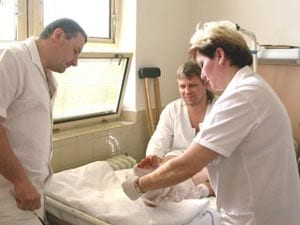 Having insects liquefy and digest the dead tissue from your wounds might not be the most appealing idea, but a research team in Hawaii has done just that — using maggots to clean infected and dead tissue from wounds in diabetics — with very positive results.
Having insects liquefy and digest the dead tissue from your wounds might not be the most appealing idea, but a research team in Hawaii has done just that — using maggots to clean infected and dead tissue from wounds in diabetics — with very positive results.
Doctors typically use scalpels or enzymes to remove dead or infected tissue from wounds in diabetic patients, whose natural wound-healing processes are impaired by a reduction in bloodflow to their extremities. Doctors call this process debridement; however, with traditional tools such as scalpels, it is often ineffective.
“These problem patients with diabetes really need better treatments in order to salvage their limbs,” said Dr. Lawrence Eron with Kaiser Hospital and the University of Hawaii in Honolulu. “Maggot debridement treatment is overwhelmingly effective,” he added. “After just one treatment these wounds start looking better.”
Dr. Eron and his colleagues presented the findings of an investigation into the use of maggots for debridement purposes to their peers at a scientific meeting in Chicago. The results of the investigation have not been reviewed by independent, outside experts.
The investigation was conducted on 37 individuals with diabetes who had artery disease that reduced circulation to the extremities and impaired their wound-healing capacities. All of the patients had wounds that had proven difficult to heal, with some of them lasting for up to five years.
Dr. Eron’s team placed 50 to 100 maggots — species Lucilia sericata — on the patients’ wounds. The insects were left on the wounds for two days and then replaced with new ones; the treatment averaged five days across the group of patients.
“We cage the maggots in a mesh-like material. Nylon panty hose might be used. And then we seal them so they don’t get out,” said Dr. Eron.
Of the 37 patients, 21 had successful outcomes, with success being defined as the eradication of infection, total removal of the dead tissue associated with the wound, formation of new connective tissue in the wound and more than 3/4 closure of the wound.
Among the patients in which the treatment failed, three experienced complications with infected bones, two experienced heavy bleeding, and one had excessive inflammation around the wound.
Five of the wounds were infected with MRSA, a “superbug” known to be extremely resistant to antibiotics; those wounds healed successfully with the use of the maggots. A bacterium called MSSA infected nine other wounds; six of those were successfully treated. Among the patients there were 10 cases of wounds infected with group B streptococci; all of those wounds healed successfully, according to Dr. Eron.
As many patients would understandably be apprehensive about having live maggots inserted into their wounds, Dr. Eron noted that it’s important to explain the process and the mechanisms behind its success to patients. “A lot of patients might be somewhat wary of having live insects placed into their wounds so we explain how it works and what possible problems might occur,” he said.
The maggots secrete a digestive substance into the wounds that break down dead tissue. They feed on this tissue, where it is further digested in the gut of the maggot. The process effectively cleans the dead tissue surrounding the wound; the digestive substance that the maggots secrete also encourages development of granulation tissue, a type of connective tissue that forms when wounds heal.
“After this, we go on to do further treatment with hydrogels, grafts of cell culture tissue, or negative pressure dressings,” said Dr. Eron. “But to get to this point where these techniques will work, you really need to clean up the wound, get rid of dead tissue, and get robust granulation tissue into the wound. And this is where the maggots help.”